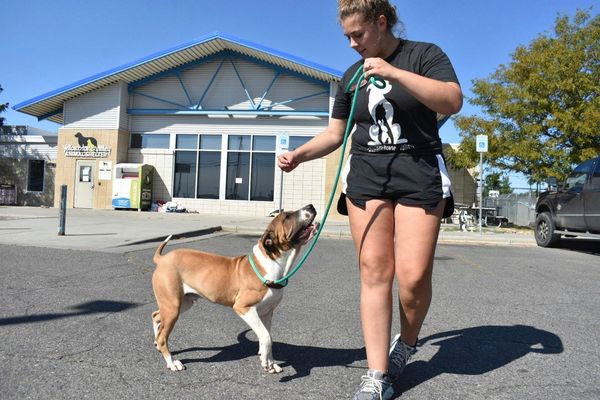
‘One of the pleasures of getting old,” says Sarah Lucas as she lights a rollup in Tate Britain’s garden, “is that a lot of your life is done and it’s not going to make that much of a bloody difference. That along with the bus pass is one of the few perks.” She throws back her hair and giggles endearingly over the sound of a bin lorry. The former Young British Artist recently got her 60-plus travel card, giving her free travel on bus, tube, local trains, even Croydon’s trams if she has a mind. “Only off-peak, though, I found to my cost,” she says. “Not that I’m complaining.”
This disdain for self-importance is no doubt liberating, though not perhaps what the Tate’s PR people want the 60-year-old to be telling the media as she promotes her career retrospective show Happy Gas. They’d probably prefer her to talk about some of the greatest hits with which she scandalised polite society and problematised the predatory male gaze at the outset of her career. The 1996 Self-Portrait with Fried Eggs, for instance, which depicted Lucas manspreading on a chair with two fried eggs on her chest, and a look at the camera that says: “Yeah. And?” Or one of her 1997 series of Bunny sculptures: headless figures made from stuffed tights draped over chairs in parodies of sexual availability and female abjection. Or Eating a Banana (1990) in which she faux-fellated fruit, meeting the viewer’s gaze while looking like a dead ringer for androgynous Suede frontman Brett Anderson.
But rehashing all that art history to big up the Lucas brand sounds like work. More instructive is to talk about the value of not working. Lucas learned the value of this early. Of all the golden generation of YBAs who graduated from Goldsmiths 30-odd years ago, Lucas was and remains the biggest slacker.

Although she now lives in Suffolk (in a house that Benjamin Britten and Peter Pears shared, no less), she doesn’t have the work ethic of that county’s most celebrated living painter, Maggi Hambling. When I mention Hambling goes every morning to her studio to paint, Lucas chuckles as if the poor mug has sentenced herself to life. “I couldn’t do that. Why would I want to?
“I remember my mum telling me not to do my homework,” she continues. “She said ‘School is where you do school work. Go and play.’” Lucas is grateful to her late mother. “Time is actually the only valuable thing,” Lucas says. “You need time to think rather than be making all the time. At least I do. That’s when inspiration hits. Or doesn’t.”
Lucas doesn’t do social media, not just because it is a massive time suck but because it’s work. And work that gets someone else paid. “These are dangerous times when what’s on your phone can be dug up at any point in the future by someone with more power than you to disseminate that information, to make money from you. Why is that worth doing?”
A product of the most media-friendly of art movements, the former YBA has minimal public exposure, lives quietly with her partner, the composer and artist Julian Simmons, and gives few interviews. “It’s not that I’m especially private. I’d just rather read books than do any of that, you know?”

Aged 16, after years of not doing her homework, Lucas left school, had an abortion and hitchhiked around Europe. When she got back, she signed on and did next to nothing. “We’re told that was a waste of public money and time. It’s not. It paid for young people to form bands, to make art. To have time to think. And that is valuable.”
It was while working at a play centre with her mother that Lucas met someone who had been to art college. “I thought, ‘I could do that.’ I’d always made things, mostly from cheap stuff.” She hadn’t quite found a vocation but at the London College of Printing and Goldsmith’s College, she not only made stuff, but became part of the most famous British art movement since the pre-Raphaelites laid down their paintbrushes.
At Goldsmith’s she was written up as the tough girl from the sink estate whose shocking art was a broadside at the heteronormative, masculinist characters with whom she grew up in pre-gentrification north London. Lucas later teamed up with Tracey Emin, becoming half of a double act and presenting a kind of ballsy femininity, sex positive and yet savvy about misogyny. “We were only together for about six months,” she says, slightly exasperated when I ask her if she keeps up with Tracey. “But I suppose that was a long time then.” In that time the pair set up a shop on Bethnal Green Road from which the canny creatives sold decorated keyrings, wire penises, T-shirts emblazoned with slogans such as “I’m so fucky” or “Fucking useless”. Art had wed Thatcherite entrepreneurialism: with Sarah and Tracey, you always exited through the gift shop.
Lucas stresses that she was a product of better times. “I wouldn’t have gone to college if it weren’t for the grants I was awarded. I wouldn’t be an artist if I’d relied on loans. If you’re from a background like mine, you don’t think ‘I’ll saddle myself with a massive loan and see how it works out’. It’s very off-putting for kids from a working-class background. Maybe it’s meant to be.”

In the catalogue for Happy Gas, there’s an insightful essay by Lauren Elkin that cites French writer Georges Perec, who urged us to attend to everyday objects in order to understand the overlooked forces that govern us. “Make an inventory of your pockets, of your bag,” he urged. “Ask yourself about the provenance, the use, what will become of each of the objects you take out. Question your teaspoons.” Lucas is a latter-day Perec, suggests Elkins. She questions her banana, her toilet, her newspaper.
And her marrows. On the lawn before us at Tate Britain are two oversized marrows, one called Florian and the other Kevin, as lumpy, public and concrete as any Henry Moore mother and baby. “Look at the birds settling on them,” Lucas says happily. Kev and Flo incarnate something central about Lucas’s art, namely the potential of everyday objects to serve as endlessly interpretable, open texts.
Her marrows might be seen as pop art pastiches of the biggest vegetables in any horticultural show. Or as erect rebukes to the dangling flaccidity of Manet’s single asparagus. Most likely they’re phallic soulmates in dialogue with some of the new sculptures she’s installing inside Tate Britain. Meanwhile, on the walls will be several of Lucas’s wallpaper designs, including Tits in Space in which the design’s disembodied breasts are made from carefully sculpted Marlboro Lights.
Much of the floor space in the gallery will be occupied by furniture, sadly not including the table first seen in the 1992 show Two Fried Eggs and a Kebab. Each day Lucas replaced the eponymous perishables representing the breasts and a vagina that the objectified female body was reduced to.
How did that first come about? “It was Andrea Dworkin who was the real eye opener for me,” says Lucas. After graduating in 1987, she felt lost in the art world through which many of her peers were navigating with great business acumen. Then she read the late American feminist’s books Pornography and Intercourse. “It was like going to college and learning how insidiously everyday life works.” Perec, as it were, but with a focus on structural misogny. Dworkin stressed that, even though the man is always possessing the woman during intercourse, a penis is vulnerable inside a woman’s vagina. Lucas’s 1992 sculpture The Odd Couple is a droll English riff on that thought. Two chairs face us: on the seat of one is a set of false teeth, on the other a dildo. You wouldn’t bet on the dildo in that fight.

Why is the show called Happy Gas? “I was just looking for a snappy two-word title,” admits Lucas. “It’s also because things are a kind of trance. We’re living in an intoxicated sort of state. Everything that we live through and don’t question, as if a happy gas permeated everything.”
As soon as the exhibition was announced, Happy Gas took on another resonance after Rishi Sunak launched a clampdown on nitrous oxide canisters. It was as if, serendipitously, she was making a critique of the manifold fatuities of government policy. Lucas, a Green party voter, says her aim is hardly ever party political. “That said, I hate the whole war on drugs, because it’s like everything else, the war on immigration or whatever. It doesn’t work.”
One of Lucas’s conceits for Happy Gas is that her banana-eating self-portraits from the early 1990s will be blown up as wallpaper. They will look down on new sculptures as if the YBA from 40 years ago is in dialogue with her 60-plus self. Those sculptures promise to be tough to install: This Jaguar’s Going to Heaven (2018), for instance, is a deconstructed car coated in thousands of cigarettes; 2015’s Pauline, Sadie and Me consists of below the waist casts and was made – in a rare bout of collaborative jauntiness that she treasures – after getting naked with friends.
Mostly, though, there will be chairs. If you were to tell Sarah Lucas’s life story as one of overcoming a psychic wound through art, then the primal scene would surely be the moment she, along with her milkman dad and part-time gardener mum, visited posher homes to, as she puts it, “ogle” the furniture. It’s as though little Sarah’s material deprivation has been answered by grownup artist Sarah’s surfeit of found objects, chairs especially. “Not really,” says Lucas when I put this idea to her. “I mean, we’re all using chairs, to prop the door open, whatever. It’s not about my deprived past. Well, not entirely.
“And I’m not acquisitive,” she adds. “I think you should move house every few years just to get rid of stuff. I do have some mugs in the kitchen that I’ve accumulated over the years and they do amuse me but they’re not precious. I’m not wedded to things.”
Lucas tosses her cigarette. Those knobs and tits won’t hang themselves. I watch her ascend Tate Britain’s grand staircase, a busy woman up against a deadline, in sensible shoes and a pink hi-vis jacket. Maybe she likes work after all.
Sarah Lucas: Happy Gas is at Tate Britain, London, from Thursday until 14 January
This article was amended on 25 September 2023. Julian Simmons is Sarah Lucas’s partner, not husband, and the Tate retrospective does not contain plastercasts of his penis. It also does not feature Two Fried Eggs and a Kebab.







